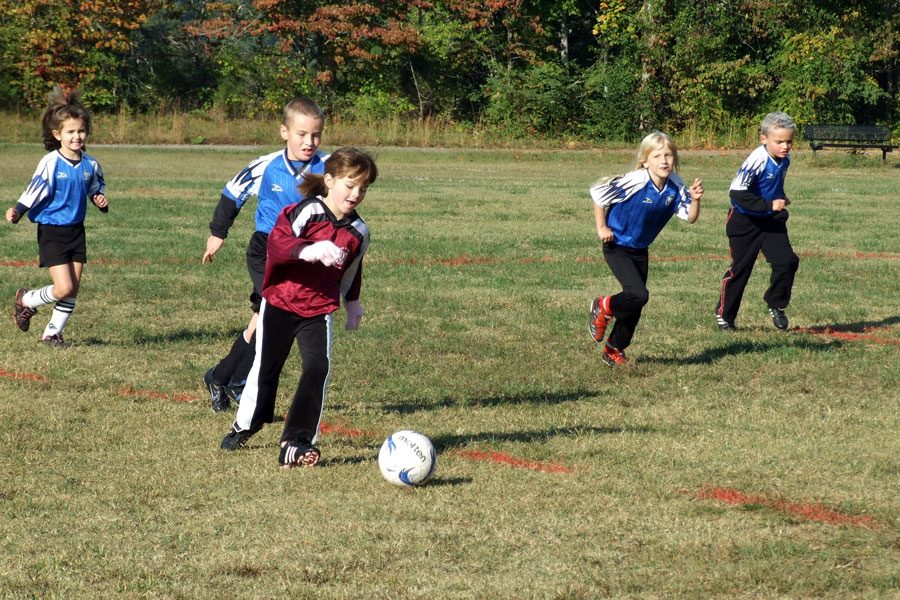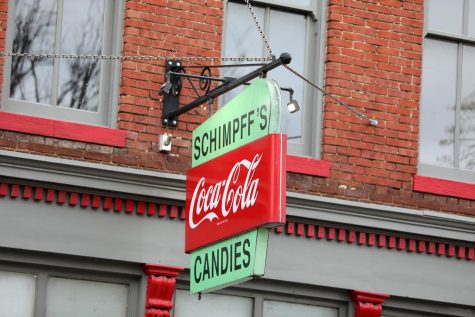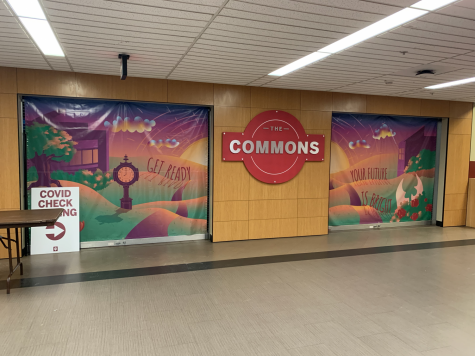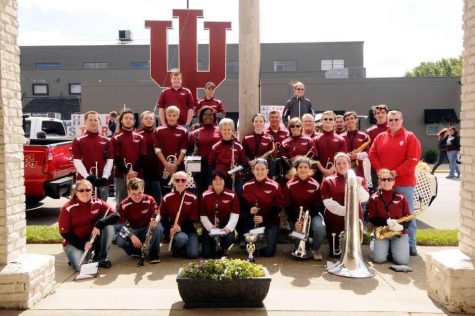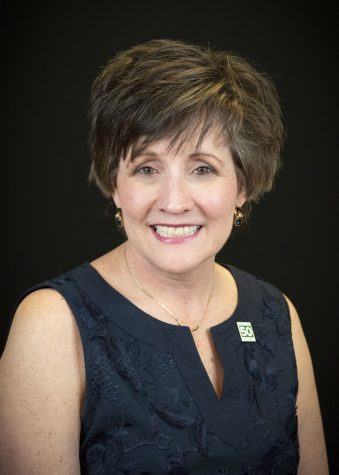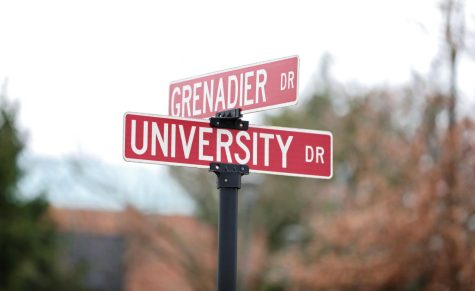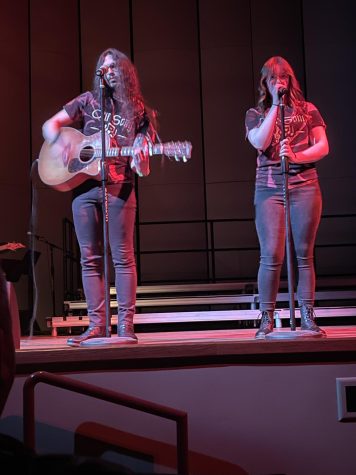A local youth soccer revival
As participation numbers are falling nationally, local recreational soccer clubs are seeing steady growth.
January 9, 2019
Crisp morning air, a harmony of chirping birds and clanking soccer cleats on pavement provide the soundscape to Saturday morning recreational soccer games. While its popularity is palpable in certain pockets of the country, a recent study found that nationwide youth soccer is on the decline.
In a study published in June of 2018, the Sports and Fitness Industry Association (SFIA) found that nationwide, the percentage of 6- to 12-year-olds regularly playing outdoor soccer fell nearly 14 percent over the past three years.
In both distinctions, participation numbers have fallen significantly. The same research report, done in partnership with Sports Marketing Surveys USA, found increases in more widely popular sports like basketball and baseball.
The SFIA report begs the question: why is soccer declining nationwide while other sports see steady — often rising — numbers?
The issue is significant in the United States, so much that it garnered coverage by Forbes and the New York Times. While there’s no explicit cause for the decline, there are a handful of potential contributing factors.
With the United States’ men’s national team failing to qualify for the World Cup earlier this year and under-performing in previous World Cups, morale around the sport may be declining.
Another potential factor is the wide range of technology available to young people. Video games and other virtual diversions like e-sports are easier to engage with and may deter youth from committing to recreational sports.
The largest and most plausible factor that drives soccer and other youth sports participation down is money.
Money as a barrier
Andrew Smith is a history teacher at Parkview Middle School. Previously, he coached the boy’s soccer team at Charlestown High School in Charlestown, Indiana for six years, leaving in late 2015.
Smith played soccer throughout his youth and has always been aware of the role money plays in recreational soccer. As a young soccer player, he remembers his father working multiple jobs and taking out loans in order to pay his entry fees each season.
Like his father, Smith has a passion for soccer that has lasted his entire life. He said, based on his experience, soccer is one of the most exclusionary sports in America with a palpable income barrier.
“The issue of how much it costs to play soccer has always been a topic of discussion in my life,” Smith said.
Expenses for soccer consist of more than yearly fees. Playing outdoor soccer requires a handful of equipment and while most every recreational sport has the same requirement, Smith says soccer equipment in America is needlessly expensive.
“For some reason in this country, you have $80 pairs of shin-guards and $200 pairs of cleats, the soccer ball costs $50 sometimes,” Smith said.
A TIME cover story in 2017 found that families spend as much as 10 percent of their income on expenses related to youth sports. Soccer ranked as the fifth most expensive sport to play.
As a coach, Smith championed a handful of outreach efforts relating to local recreational soccer. He collected used soccer cleats to distribute to players who couldn’t afford any.
Additionally, Smith hosted free sessions of futsal during the winter at Charlestown’s middle school and high school. Futsal is a variation of soccer played indoors, with teams of five using a smaller ball.
Developing Local Youth Talent
Smith was deeply involved with the soccer community in and around Charlestown. In addition to coaching the high school team and leading futsal sessions, he coordinated efforts with parents and players in the community to get low-income players into recreational teams.
The recreational soccer league he strongly recommended to his players — current and future — was Clark County Soccer Association (CCSA.) CCSA is a non-profit recreational soccer organization founded in 1990. Its games and practices are held at the Woehrle Athletic Complex in Jeffersonville, Indiana.
Smith would recommend that his players enroll in CCSA’s spring session during the high school’s off-season. This would let students gain more experience playing on a team with one another. By his own estimation, CCSA’s player base was composed of “50 percent Charlestown kids” for several years in a row.
Louisville City FC (commonly known as Lou City) is a professional United Soccer League team based in Louisville, Ky. Its popularity has rapidly increased since being founded in 2014, with the team recently winning their second straight USL championship.
Scott Stewart, director of PR and broadcasting at Louisville City FC, says the organization also has a hand in developing local youth talent. Lou City offers youth camps every year sponsored by the club, with some being hosted by some of the individual Lou City players.
“As a club, we are committed to putting the best product forward that we can and that includes youth development in Louisville and the surrounding area,” Stewart said.
CCSA: Accessible and Successful
Clark County Soccer Association is immune to the perceived decline in youth soccer participation, as president Michael Vejar said numbers have steadily increased each year. Overall, the organization has seen a 41.8 percent increase in its player base since 2011.
Vejar has been president of CCSA since March of 2018, but has been involved with the organization since 1992. He has served as Director of Coaching, Sponsorship Commissioner and Equipment Commissioner in the past.
Affordability is one of CCSA’s strongest aspects, although Vejar says that comes down to it being solely recreational soccer. Other local clubs like Southern Indiana United and Louisville Soccer Alliance offer competitive play which entails more expenses.
Players looking for recreational soccer but unable to cover the often-high costs find a home at CCSA, where financial assistance is available to those in need.
“We also have a scholarship program that enables financially challenged families to play at CCSA for reduced or no cost to them,” Vejar said. “They have to apply each season and our Board Of Directors reviews each application.”
Trending: National vs Local
Regarding the SFIA’s research and statistics, Vejar says they could be skewed. He has noticed that soccer — across all age groups and types (CORE, casual, indoor, outdoor) — is steadily increasing, but “national trends want to make it look like it’s not.” The participation data from CCSA backs up his claim.
On the topic of national numbers appearing to be down, Vejar said while he doesn’t pay much attention to national trending given the rising local trend, he has some ideas.
Soccer is widely considered the world’s sport, given its worldwide popularity. In the United States, athletes have a wider selection of sports to play, which Vejar says could explain the national trends.
“Baseball and football are legacy sports that few other countries play at an equal professional level,” Vejar said. “Soccer, on the other hand, is ‘the world’s sport’ and most all countries are immersed in it year-round.”
The United States does have more widely popular sports than soccer: baseball, basketball and football are more monetized and ingrained into pop culture. However, Vejar says there is a generational factor to consider when talking about soccer’s popularity.
Growing and Growing
CCSA isn’t the only local soccer organization seeing steady participation growth. Mockingbird Valley is an indoor soccer and field hockey club located in Louisville, and it has seen an overall increase of 34 percent in soccer participation since 2014.
Mockingbird Valley offers indoor soccer sessions all year: one spring session, two fall sessions and two winter sessions. Kristen Wallace, director of operations and Mockingbird Valley, says Mockingbird Valley’s strength is its uniqueness, as indoor soccer is vastly different than outdoor soccer.
“Popularity has been increasing so much that we had to start offering the second fall session in 2017,” Wallace said.
Flawed Findings
The numbers from Clark County Soccer Association and Mockingbird Valley seem to dispute the SFIA’s findings about youth soccer numbers. Locally, the sport is seeing steady growth.
Why are trends in the Louisville area drastically different from the nationwide statistics? Could it be an anomaly — is Kentuckiana a strong pocket of the country for soccer?
It could be that the SFIA’s findings are flawed. In an interview with the Los Angeles Times, Mike Hoyer, executive director of the American Youth Soccer Association (AYSO,) criticized the SFIA’s findings. Hoyer called their findings a “sliver of a data point.”
There are hotbeds of recreational soccer activity spread across the country, from Maryland to California. Indiana and Louisville have also been referred to as soccer hotbeds.
The national participation rates are inconsistent. Maybe it’s better to look at the numbers under a microscope, analyzing local trends instead of broadly generalizing the national data.

